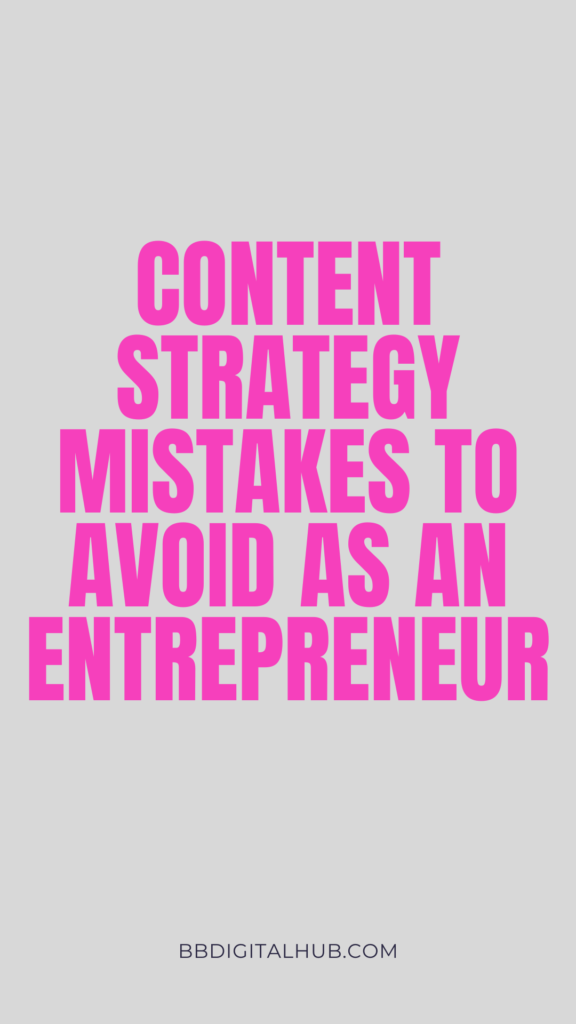Your cart is currently empty!
Content Strategy Mistakes to Avoid as an Entrepreneur
•
This page may contain affiliate links. If you follow a link to sign up or make a purchase, I’ll earn a small commission at no cost to you.

You’ve been showing up. Posting consistently. Following all the advice.
Yet your content still isn’t getting the results you want. It’s frustrating. It’s discouraging. And it makes you question whether this whole content thing is even worth it.
I know what that’s like.
It took me about a year of creating underperforming content to realize that my problem wasn’t the algorithm or people’s short attention span.
It was because I was making silly mistakes with my content that was costing me.
These mistakes are often overlooked, yet if you’re able to spot and fix them, your content will perform better, and you’ll start seeing the results you want.
So, let’s break down five simple mistakes you’re making with your content.
5 Simple Mistakes you’re Making with your Content
Focusing on Virality Instead of Longevity

I have nothing against going viral, it’s fun, exciting, and makes you feel good about the content you created. The issue is desperately chasing and seeking it as if it’s the answer to all your problems.
Spoiler: it’s not.
Yes, going viral can jump-start your business and expose you to a new audience. However, just like every trend, its effects are short-lived, and most entrepreneurs don’t know how to turn that virality into something that matters, i.e., conversions.
When you focus your whole social media and content strategy on chasing trends and going viral, you’ll see that the ‘results’ you get aren’t moving the needle.
Sure, you’ll get tons of likes, but what about genuine interest in what you offer?
You’ll even get followers, but will they form a strong community around your brand? Not likely.
Instead of prioritizing virality as the goal because you think it’ll yield the best results faster, focus on longevity.
Have you ever heard the phrase: slow and steady wins the race?
This is particularly true in the context of content marketing.
Don’t become so consumed in chasing viral hits that you let it distract you from what matters, which is creating sustainable, high-value content that will build trust and authority and attract your ideal audience to you.
I know it’s easier said than done, and the process can be very slow, but keep at it and you’ll be rewarded in the long run.
Having a few trends here and there is fine as long as they fit your brand and business.
Action step: Take the time to brainstorm content ideas that address your audience’s needs and wants.
Creating Content Without an Exit Strategy

Ever feel like your content is getting attention but not action? That’s because people don’t know what to do after they see it.
A mistake I see most people make is that they never consider the after.
- What happens after people see your content?
- Are there any next steps you want them to take?
- Does it lead them anywhere?
- Are they aware of what to do?
- Or does your content have no impact on them whatsoever?
- After they see your content, do they just keep scrolling to the next thing, or do they inquire more about you?
If your content doesn’t intentionally guide your audience toward a specific next step, you’re building excitement without channeling it anywhere meaningful.
Every piece of content should have a clear goal, a next step, or an exit strategy.
An exit strategy is the planned pathway or action you guide your audience to after they consume your content. It answers the question, “What do I want my audience to do next?”
Remember that the reason you’re spending all this time creating content is that you want the content to lead your target audience not only to discover your business but also to take a specific action, aka convert.
The conversion can be signing up for your email list, booking a call, buying a product, or booking a service.
Never assume your audience knows what to do. TELL THEM WHAT TO DO.
For example, one of my clients is a content studio and their goal is to increase booking to their studio. While that is fairly obvious, I still include it in their content to encourage their audience to book with them.
The same applies to my blog posts; I always ensure that I include information about subscribing to my newsletter because that’s the action I want people to take.
Good content is purposeful content.
Action step: Before creating any content, ask yourself, “What action do I want the reader to take after consuming this?” Be specific and intentional.
Create CTAs that are specific, relevant, and aligned with the content itself.
Over-Personalizing your Content Strategy
Being yourself and having an authentic brand doesn’t mean sharing every aspect of your life.
I know you’ve heard ‘authenticity’ and ‘show your personality’ so many times it’s lost all meaning. But if no one has told you before, I will be the first to say:
You don’t have to share everything.
Your audience doesn’t need to know how you take your coffee, exactly where you’re taking your next trip, your mother’s maiden name, or what your kid did in school today.
You’re building a business, not a tell-all series. Your audience doesn’t care whether you like matcha or not; they care about how you can improve their lives.
Be strategic with the personality you show. Your content should only show what is relevant to your audience. Only show what will emotionally motivate them to perform the desired action.
Inject your personality into your content, but don’t tie it to things YOU think are interesting, tie it to the things your audience will relate to in terms of their needs and wants.
Action step: Take the time to get to know your audience deeply, noting their needs, wants, likes, dislikes, challenges, and aspirations. Then, as you plan your content, think of ways to infuse your personality into it in a way that best reaches and resonates with your audience.
Relying Too Heavily on Competitor-Inspired Content
Is there such a thing as an original thought? Or are we all just copying each other all the time?
While competitor research and analysis are crucial to any content strategy, many people get too tied to what they find.
They focus so much on what their competitors are doing that they overlook their thoughts and ideas entirely.
I’ll be the first to admit that I’m guilty of this.
In the past, I’ve gotten so wrapped up in what other people were doing in my industry that I either just replicated exactly what I saw without thinking or I got too overwhelmed with all the information I was taking in and did nothing.
You don’t want this to be you, and if it already is, you need to snap out of it.
The purpose of studying your competitors is not to duplicate but rather to observe, learn, adapt, and improve.
Constantly checking what others are doing is a great way to limit your originality and personality.
Instead of standing out and being better than the competition, you end up looking like everybody else, doing the same thing.
Action step: Building on the previous point, be strategic about how you infuse your personality into your content; this is what sets you apart. Use your knowledge of yourself and your audience to come up with ways to make your content and business better than the rest.
For example, nothing I discuss on this blog is new information. But im able to stand out and reach my audience because I infuse my personality into everything.
I share my stories (only the relevant ones), lessons, and viewpoints to differentiate my business.
Misjudging Content “Value”

‘High-value’ content does not equal long and complicated content.
I know there’s a rat race of entrepreneurs all trying to produce the highest value of content ever known to man. And in trying to do so, you might think it means providing more length, more detail, and more complexity.
But be careful.
This assumption can lead you down a path where your content becomes overwhelming, dense, or simply too difficult for your audience to both consume and enjoy.
In today’s age, where people’s attention spans are growing shorter, the most valuable piece of content is not necessarily the longest, but rather the shortest and most easily understood.
Straightforward, easily digestible content helps your audience quickly grasp key points, increasing engagement and retention.
Real content value isn’t measured by how much you include but by how simply and effectively you communicate your ideas to your audience.
Action step: when creating content, Ask yourself, “What is the single most important takeaway?” then build your content around this singular idea rather than multiple competing points.
Edit ruthlessly and remove unnecessary explanations. Focus on making your message as clear and accessible as possible.
If you’ve been stuck, spinning your wheels, or feeling like your content isn’t “working,” chances are you’re making one (or more) of these mistakes.
But now you know better.
You know that virality isn’t the goal. That every post needs a purpose. That authenticity has limits. That your voice matters. And that simplicity is power.
Fix these mistakes, and you won’t just create better content, you’ll build a stronger, more profitable brand.

Join Our Community Today
Get exclusive access to straightforward marketing strategies tailored for beginners.

Leave a Reply